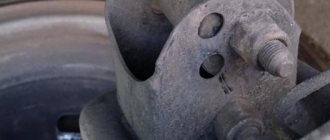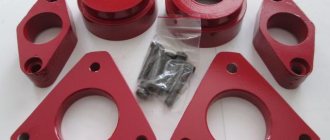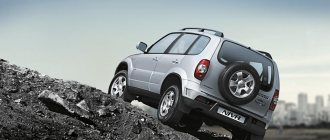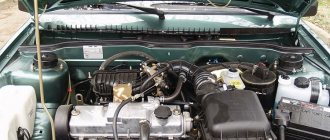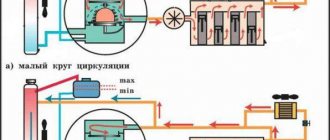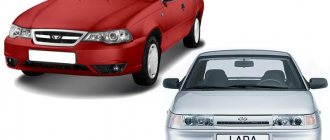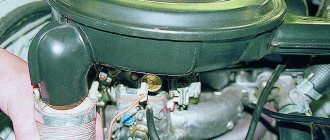Material characteristics
This model is a cylinder shape that is mounted under shock absorbers and suspension springs. Different materials of manufacture, density and dimensions of spacers for increasing ground clearance are determined by the purpose of installation on the front or rear of the car body. As a rule, the choice of one spacer or another does not depend on the make of the car: most parts are universal.
The material used to make parts can be divided into metal (steel or aluminum) and non-metal (polyurethane, plastic). Metal spacers are mounted under the spring, and non-metal spacers are mounted above the spring.
To have a clear idea of the subject, you can watch the installation of a spacer to increase ground clearance with your own hands in the video.
What is it for?
There are two reasons for raising the vehicle's ground clearance:
- off-road driving;
- sagging of springs over time.
To restore the spring to its original position, special spacers are used. The ideal option would be to replace old springs with new ones at a service station; however, car owners widely practice installing spacers to increase ground clearance with their own hands. If previously, increasing ground clearance was achieved by introducing tennis balls into the springs, now car dealerships sell special spacers of various thicknesses.
How to increase ground clearance (clearance)
Increasing ground clearance is most often done by off-road driving enthusiasts, hunters and other people who like to go out of town. Roads in the city are significantly different from country roads. That is why increasing the clearance for cars unsuitable for these roads is one of the most important procedures.
- First method. An increase in ground clearance is achieved by installing wheels with a larger diameter. This is especially true for cars with basic equipment.
Among the disadvantages of this method are the appearance of a speedometer error and the limitation of the diameter by the wheel arches. This means that if you install a wheel that is too large in diameter, it will hit the arches on sharp turns.
- Second method . Installing spacers under the fastenings of suspension parts to the body, for example, springs, also allows you to increase ground clearance. Complete with spacers, you should purchase shock absorber extensions, or new extended shock absorbers, since when entering a deep hole, the shock absorber may fly out of the cup.
The disadvantage of this method is that the rear spacers are much thicker than the front ones and the increase in ground clearance occurs unevenly. In this regard, the brake force regulator, or “sorcerer” as it is called, receives incorrect information. However, the “sorcerer” has the ability to regulate.
- Third method. It is reminiscent of the second method and consists of replacing standard springs with springs with a large number of turns. In this way, a significant increase in ground clearance can be achieved. However, as in the second method, it is necessary to lengthen or replace the shock absorbers for the same reasons.
Compared to spacers, new springs will last much longer and more reliably, however, in addition to the same disadvantages, they have a high cost.
- Fourth method. Reinforced springs. This option is used for vehicles that are operated at full load. They can be pickup trucks and station wagons, which have the ability to transport large cargo. Reinforced springs do not increase the vehicle's ground clearance, but their use eliminates "sagging" under full load, while maintaining normal ground clearance and protects the underbody from damage due to uneven road surfaces.
Among the advantages of this system, one can note an increase in the service life of the entire chassis, however, the comfort of a trip without a load is reduced, since the rear part will “spring” on small bumps.
ADDITIONAL SPRINGS
Almost all the same “delights” await those who, having abandoned the idea of spacers, decide to install non-standard shock absorber springs on the car - those with a large number of turns. The procedure, let’s say right away, is not cheap, since in addition to purchasing reinforced springs, you will need to purchase long-stroke shock absorbers. And set aside money for a wheel alignment - you will need it too.
IS IT WORTH IT?
Official dealers will not be able to raise their LADA Granta or KIA Rio - servicemen at “white” service stations neither install spacers nor change springs to non-standard ones. It turns out that in pursuit of increased ground clearance, which will not give freedom, you can lose not only money, but also the factory warranty if the car is relatively new.
So, what do you get by trying to lift your car using one of the above methods? A couple of centimeters to the ground clearance - yes. But at the same time, you will face possible problems with the officials, a decrease in suspension resources and high costs - if, say, spacers or springs do not fit the first time and you have to take others. So maybe it’s easier to save up a little and change the car to a crossover?
Pros and cons of the clearance operation
Is there really a need to tune the suspension, and will such a change damage the car? Before installing aluminum spacers under the springs, let’s pay attention to the positive aspects of the changes:
- protection of the rear suspension, underbody and crankcase from breakdowns;
- protection of the rear wheels from impacts on the fender liner;
- increasing the vehicle's off-road capability.
The disadvantages of installing a spacer under the springs with your own hands include:
- failure of the lower shock absorber mounting;
- additional load on the bottom bracket;
- car instability on an icy surface;
- impairment of vehicle controllability due to a shift in the center of gravity;
- rapid wear of steering parts;
- imbalance of wheel alignment.
After tuning, the car owner needs to pay more attention to the suspension in general and shock absorbers in particular.
How to influence the clearance level?
How to increase the clearance in your car? If you install wheels with an increased diameter and profile, then the ground clearance will certainly “increase”. It is interesting to consider an example of such forced action when using wide 215x55xR15 tires. With an increase in profile by 5%, the increase in clearance is 1 mm. Adding another five percent to the profile will increase the clearance by 2.5 mm.
If you are inclined to increase the wheel size, you should take a look at the factory recommendations. The maximum size of factory-installed tires reaches 185x60xR14 for the standard version of the Lada Kalina 2 and 185x55xR15 for the Cross version. Theoretically, it is possible to install a tire size of 195x40xR17, however, one should take into account the risk of tires hitting the wheel arches when driving over uneven surfaces and other consequences for the suspension that can cause its premature wear due to the increased weight of the wheels.
Also, an increased tire height can shift the center of gravity upward, which will worsen handling. Another important aspect is the danger of deformation of the rubber profile of the tire under the influence of the same increased weight. Here again there is a risk of rollover when cornering at increased speed, because body roll inevitably increases.
Let's also note the positive aspects of the larger wheels. This is not only an increase in ground clearance, but also an improved ability of the body as a whole to perceive unevenness in the road surface. The ride of the car is soft and smooth. Now you know how to increase the clearance of Kalina.
What to choose?
What are spacers made of to increase ground clearance? The choice of material depends on the design of your machine. In the front compartment of the car, spacers made of metals are mounted: steel or aluminum alloys. It is recommended to place rubber or plastic products under the rear springs.
Which spacers are best for increasing ground clearance? Firstly, you cannot install any spacers over 30 mm thick. Secondly, polyurethane products can cause damage to the body by steel bushings due to rapid wear.
Aluminum products are the most reliable, although they cause corrosion at points of contact with the body. In practice, plastic spacers have shown themselves to work well to increase ground clearance, without revealing any serious shortcomings. Rubber material is the cheapest, but is prone to tearing, deformation and rapid wear.
About the body and suspension lift
How to correctly install spacers on the rear pillars of a VAZ 2110
If you are the happy owner of a VAZ 2110, then you were able to fully appreciate the undemanding and easy operation of your dozen. But one day, if you have had the car for a long time or got it from someone, you will notice that it has begun to sag a lot. This can be noticeable even with a completely empty cabin and tank. The consequence of this subsidence will most likely be impacts from the tires into the fender liners. And, as a consequence, their mutual destruction.
You can solve this problem of your VAZ 2110 by using spacers for the rear springs by contacting the nearest car service center, but it will be much cheaper and more interesting for any real car enthusiast to solve the problem on their own. Moreover, the process of installing spacers will not take much time.
The procedure for installing spacers on the rear pillars of a VAZ 2110
All you need for this operation are the spacers themselves for the rear springs for the VAZ 2110, a small set of tools and a little accuracy.
Let's look at the whole operation, breaking it down into 16 stages:
- First of all, using available tools, you need to hang up the rear part of your VAZ 2110 and remove the rear wheels;
- Next, taking a 19mm wrench, you need to unscrew the bolt that secures the shock absorber from below. To prevent the bolt from turning, securely fix the nut with another suitable wrench.
- Remove the bolt.
- We take one of the spacers. Which one is not important, since they are symmetrical and equally suitable for any side of the VAZ 2110.
- We orient the spacer with the larger side facing longitudinally in relation to the length of the car.
- The spacer has three holes that connect it to the end of the shock absorber. You need to select one of the holes depending on what lifting height of the VAZ 2110 you need.
- Remember which hole you chose, you will need to select a similar hole on the other spacer.
- We mark the longitudinal axis of the shock absorber and mentally draw an imaginary line through the centers of the holes with which the spacer is attached to the bottom of the shock absorber and the beam. This line must be vertical.
- Observing all of the above, you need to put a spacer on the eyes available in the beam.
- Between these same eyes we place a spacer sleeve.
- We fasten everything with the appropriate bolt.
- Tighten the nut. To do this, you should use a torque wrench. It will allow you to maintain the optimal, in this case, force - about 80 Nm.
- Next, the bolt is also inserted into the shock absorber bushing. Tightens his nut. The recommended force is the same as in the first case - about 80 Nm.
- Next, we proceed to install the pressure regulator. To do this, you need to press on the car trunk with a force of about 45 kgf.
- After this, loosen the pressure regulator bolt connecting it to the regulator drive lever.
- Using a suitable screwdriver, move the lever bracket until the gap between the lever and its spring is about 2.05 mm. Use a wire of suitable thickness to check the distance.
Installation Rules
To properly make spacers for springs with your own hands, you need to take into account some nuances:
- Setting the ground clearance above 30 mm leads to wheel alignment problems.
- It is not recommended to install metal products that have not been pre-treated against corrosion.
- It is recommended to raise the front of the body by no more than 20 mm.
- The rear compartment of the body is raised by no more than 30 mm.
- If the shock absorber is not located next to the spring, spacers should be mounted under the springs and shock absorbers to balance the structure.
Real car clearance measurements
Let's determine the ground clearance without applying the previously specified regulatory load. How to do it? Let's use a tape measure. We summarize the results of real measurements in a table.
An interesting experiment was carried out, the purpose of which was to check the veracity of the ratio of the ground clearance of the Lada Kalina in its usual version in comparison with the “Cross” version. For this purpose, 4 measurements were performed. The ground clearance was measured from the road surface to the side sill with the preliminary installation of a jack. For the purity of the experiment, it was necessary to place both cars in identical conditions. Both Kalinas were presented for testing with empty interiors and luggage compartments, as well as with a minimum of fuel in the tanks.
The regular version of the Kalina was shod with 14-inch radial tires of 175 width and 55 profile. The “cross” variation received 15-inch tires, the width and profile dimensions of which were respectively “195x55”.
The first to be measured was the Lada Kalina 2 in its standard version. In the no-load state, the ground clearance reached 198 mm. During the measurements, the “cross” version received a ground clearance of 217 mm.
Front installation procedure
How to install spacers to increase ground clearance in the front part of the body? To do this, follow the recommendations:
- We lift the car with a jack, remove the tire, disconnect the braking system and the stabilizer link.
- We install other bolts of the required size on the rack (the old ones do not fit in length).
- We fix the spacer to the bolt and assemble the entire structure to its original state.
For greater clarity, you can see the diagram for installing a spacer to increase ground clearance with your own hands in the drawings.
Rear installation procedure:
- We disconnect the thresholds under the loading compartment lid and the rear door area.
- Move back the rear seats.
- We remove the panels and leave one body.
- We remove the wheel.
- We install the bolts according to the example of the front part of the body.
- We assemble the structure in reverse order.
If the word “jack” causes you vague anxiety, and the idea of the location of the bolts seems unclear, watch the procedure for installing a spacer under the springs in the video.
When creating a car, design engineers calculate every millimeter, establishing a certain balance between the parts and assemblies of the vehicle. Any change made to the design of a car in order to improve technical characteristics introduces a certain imbalance into the overall structure.
It is not always possible to increase the cross-country ability of a car designed to drive on asphalt. No matter how hard you try to change or improve the condition of the suspension using various manipulations, you will not be able to improve the design to the condition of an SUV. Either buy an SUV, or resign yourself to driving on city highways.
How much will the ground clearance increase after replacing the wheels and tires?
difference in ground clearance on different wheels Depending on the configuration of cars of the tenth family, wheel rims are installed with a 13th or 14th radius. If you replace the standard wheels of a car with wheels of a larger radius, then no matter how you look at it, the vehicle's ground clearance will increase. As well as replacing tires with higher ones (for example, 175/55 R13 to 175/65 R13).
It is important to know what size of wheels and tires is the maximum permissible for a particular car (data for wheels/tires according to VAZ 2110). I wouldn’t be surprised if, after installing high tires, the wheels start to touch the fender liners.
What is it about
Before you figure out what spacers are to increase ground clearance, you need to figure out what ground clearance is. clearance, in other words ground clearance , is the distance between the lowest point of the car body and the road.
Actually, why does a motorist need to increase the ground clearance? As already mentioned, various situations can lead to the fact that the ground clearance is reduced (damage to springs and fasteners, for example), or the factory one was not high enough. A car is, first and foremost, a means of transportation. A vehicle that sits tightly to the ground will not be able to drive without damaging the underbody. This can have a serious impact and make the car unsuitable for driving, which is why the question arises of increasing the distance to the road. Also, increasing the ground clearance is of interest to people who like to drive off-road.
So, increasing ground clearance is often done using special spacers. This is especially common in the case of subsidence of “native” springs. These spacers are spring mechanisms or additional fasteners. They cope with the task of increasing the clearance very well. Moreover, the procedure for attaching such magnifiers is the most accessible, since they themselves are not expensive - one spacer can be purchased for a price of 1000 rubles .
Air cylinders also cope just as well as spacers . It turns out even cheaper, and a “healthy” car with working springs does not suffer.
However, to decide whether such a modification is necessary, risk factors must also be taken into account. Of course, this idea has plenty of advantages, but it is not without its disadvantages - one way or another, any change in the “native” design always lies on the conscience of the motorist, and no one gives guarantees for its effectiveness. Before deciding to modify to increase ground clearance, weigh the pros and cons.
Higher, and higher, and higher: how and why to raise the car body with spacers
Looking at the cars that drive around Russian cities, you might think that all the car manufacturers have colluded and are producing cars of the wrong height. How else can we explain the fact that a huge part of our population has a desire to either lower the car or raise it to an unattainable height? Let’s put aside the questions of lowering for now and talk about how and why car enthusiasts lift their cars with spacers.
What is clearance?
If you think that a car's ground clearance, also known as ground clearance, is the distance from the lowest point on the bottom of the car to the supporting surface (road surface), then you are mistaken... This lowest point is not sought for measurement over the entire area of the bottom of the car, but only on its so-called “central part”. The concept seems vague, but there are simple formulas for calculating it. There is no point in delving into them. For ease of understanding, the “central part” of the average sedan, used to determine ground clearance, looks something like this (marked in red):
As we can see, many points of the lower part of the body (suspension elements in the wheel area, marked with arrows, mudguards, sill plates, muffler tips and some others) are not taken into account when determining ground clearance and can (and do turn out to be!) noticeably closer to the asphalt than that point , which is taken as a reference when determining the official value of ground clearance. And if you consider that the factory clearance figures for foreign cars are most often valid only for an empty car, without cargo or passengers, then you shouldn’t be surprised when a city car scrapes its bottom on a completely harmless dirt road on the way to the country.
As a result, many car owners, who are not ready to buy an SUV or at least a crossover, seek to “raise” their sedan in order to make it more versatile. By installing tires with a larger diameter from the list of sizes allowed by the manufacturer, an honest centimeter and a half height is gained, however, purchasing new wheels is expensive, and some sizes are even rare. Therefore, the method of raising the body with spacers has gained significant popularity. Let's look at its features, pros and cons.
Spacer design
Spacers are divided into front and rear, differing in design. For a full “lift”, necessary to increase the vehicle’s cross-country ability off asphalt, all four are installed. But sometimes they make do with a pair of rear ones for partial lifting, which is usually required when there are frequent suspension breakdowns and the bottom touches uneven roads from carrying heavy loads in the trunk or three passengers on the back seat.
Front spacers (we are talking about MacPherson suspension) are installed between the shock absorber strut support and the body. They are rings made of hard plastic or aluminum. Rear spacers are installed between the body and the spring of the rear axle or beam. They look like “steering wheels” made of dense rubber or polyurethane with a diameter corresponding to the diameter of the spring.
What does a spacer change?
A spacer mounted above the A-pillar mount raises the body above the A-pillar, thereby increasing the angle of the lower A-arm. As a result, the body and those “clinging” parts that were actually lower than the official ground clearance figures (sills, bumper edges, mudguards, etc.) “rise” above the road by the size of the spacer (value “B” in the picture). It is important to note that the position of point “A”, located on the lever in the area of the ball joint, does not change. Where you would have caught a stump or cobblestone under the lever on a non-lifted car, you will catch it on a lifted one. The lift of point “A” can only be increased by installing wheels of larger diameter.
The picture above is of the front axle of the car. In the case of the rear axle, everything is not so clear. No, if the rear axle also has an independent suspension - the same MacPherson strut or multi-link - then the effect of increasing the ground clearance will be exactly the same as in the first case. However, if the rear of the car has a “cart design” (a U-shaped torsion beam or a continuous drive axle), then the effect of increasing ground clearance does not occur even in the central part. The body is raised above the bridge, and the gap between the bridge and the road remains unchanged.
However, this does not mean that rear spacers in the case of dependent or semi-independent suspension are useless. The body still rises, which means the likelihood of the back of the sills, bumper or muffler touching the ground on bumps is reduced.
Of course, like any abnormal intervention in the car’s design, installing spacers is a double-edged sword. She gives one thing and takes away another...
The first thing you will probably lose is the chassis warranty. In addition, you must clearly understand that the suspension behavior initially calculated by the engineers will change. Cross-country ability will increase slightly, but at the same time, the vehicle's handling at high speeds and during maneuvers will inevitably deteriorate. However, widespread practice shows that if you don’t get carried away with height, but limit yourself to 15-20 millimeters that are considered the most reasonable for a sedan or hatchback, then the negative impact will not be too significant.
In the case of tired, sagging springs, which, for example, there is no money to replace yet, spacers of small height will not provide additional lift at all, but will only return the original position of the body in relation to the asphalt. Although this measure is, of course, temporary: neither “shrunken” springs nor dead shock absorbers can be healed by any spacers.
Installing spacers
If you nevertheless decide to install spacers, we will tell you about the technical nuances of this procedure, which will allow you to evaluate your capabilities and decide on the order of its implementation.
To install spacers on the front of a car with MacPherson struts, it is necessary to completely remove the two front struts. There is no need to disassemble the removed stands.
In the standard upper supports, the mounting studs are extended. To do this, you will have to knock out the original studs, and hammer in longer ones from the kit in their place. Another way is to screw threaded extensions onto the original studs, which are often included with spacers. After this, the spacer is “clapped” onto the extended fasteners, and the rack together with it is installed in place.
All of the above is a fairly simple task that a handy car enthusiast with a suitcase of wrenches and a jack can handle without much difficulty. However, what was an ordinary activity for fathers and grandfathers, today can cause horror among their descendants, and in this case, it is probably better to entrust the procedure to an unofficial car service center. Moreover, after “lifting” the suspension geometry changes, and a mandatory procedure for adjusting the toe-in and camber angles will be required.
Installing the rear spacers, oddly enough, is somewhat more difficult than the front ones. Formally, it seems simpler: you need to completely remove the springs, pre-compressed with special ties, and push them back in with spacers. However, this is only half the battle.
You will still have to lengthen the shock absorbers, because due to the changed suspension geometry, the working stroke of their rods will shift. In a static position, they are extended almost all the way, which when working on rebound (for example, when a wheel falls into a hole) causes a hard impact. Therefore, the shock absorber must be extended by the thickness of the spacer (or better yet, plus another ten millimeters). This is done in three ways.
The first is replacing the shock absorber with a longer one, from a different car model, but with similar upper and lower mounts. You can find out about the existence of such on the thematic forum for your car. It depends on your luck, because extended shock absorbers suitable for what is called “bolt-on” may simply not be available in nature. In this case, the second method is practiced - lengthening the shock absorber rods using extensions, often called “soldiers”. And the third is extending the shock absorber from below by installing eye extensions.
Pros of this idea
A modification that has only disadvantages usually disappears quickly. The installation of spacers continues to this day. Therefore, there are significant advantages to this.
The advantages of spacers include:
- Increased cross-country ability . It will become easier to drive the car off-road; various bumps and unevenness will be overcome without difficulty. The likelihood that a car driving over hillocks will “sit on its belly” is reduced. In such unpleasant situations, the help of outsiders is usually required.
- Reducing the likelihood of damage . When actively driving off-road or even sharply braking on a flat road with low ground clearance, the percentage of damage is always high; you can accidentally scratch the bottom, damage components: fuel lines, wiring, small parts, etc. There may not be anything “vitally important” located in the lower part of the car, but serious damage can cost the life of your iron friend.
- Preventing "accidental touches" . The car’s bumper or lower body will no longer touch various bushes, curbs and other objects that can be found on uneven terrain.
- Improving the appearance of the car . One way or another, with high ground clearance, even a Soviet passenger car will look more impressive.
- The ability to maintain normativity . There is a certain standard for ground clearance for each brand of car. When it decreases excessively, the vehicle becomes uncontrollable or difficult to control, which is rarely liked by the owners. When installing spacers, it is possible to maintain the standard.
How to raise the rear suspension on a VAZ
- For what
- Let's improve the VAZ 2110
- Other models
- By replacing struts and shock absorbers
- Video
Everyone is familiar with the problem of poor quality road surfaces in our country. In such conditions, many drivers decide to raise the rear suspension of their car, and since the majority of the population in Russia drives VAZ cars, this article will look at how to raise the rear suspension on the VAZ 2110, 2107 and 2115.
For what
The rear of the car can sag a lot.
Reasons to raise the rear suspension:
- Of course, increased cross-country ability. When hitting bumps, the car's wheels hit the wheel arch liners; many people raise the suspension to correct this problem.
- Increased load capacity. If you load something heavy into the car, the springs cannot withstand it and the rear end drops significantly. To avoid this, you need to raise the rear suspension.
Spacers
To raise the rear suspension of any of the three cars in question, spacers are needed. On the VAZ 2110 and VAZ 2115 they look the same, but on the VAZ 2107 they are slightly different.
It is important to consider that when installing spacers the following changes:
- direction of headlight beams;
- rear brake pressure regulator position;
- castor (the longitudinal inclination angle of the front wheels' turning axis).
Let's improve the VAZ 2110
To raise the rear suspension on a VAZ 2110 you need to:
- Put the car on the handbrake.
- Using a jack, raise the rear of the car so that the wheels are in the air and rotate freely.
- Remove the wheel.
- Unscrew the shock absorber mounting bolt. To do this you will need a key “19”.
- Get the bolt. Perform a similar operation with the opposite shock absorber.
- Take the spacer and determine on which side the distance from the base to the first hole is greater. The side where it is larger should be directed inward. The same spacer can be installed on both the right and left shock absorbers, since these devices are mirror symmetrical.
- Install the spacer so that a line is drawn from the center of its lower hole to the upper hole, which falls into the vertical of the rack. You can install the spacer so that it is not adjustable in height by screwing the shock absorber into a single hole.
- By unfolding the spacer, you can adjust the suspension height by screwing the strut into the upper or lower hole, but the device will then need to be placed on the opposite rear shock absorber.
- When installing a spacer on an eye, it is important to install a bolt spacer so that the mechanism does not break during operation. You don't need to tighten the bolt too much, just make sure it fits snugly and doesn't wobble.
- Install the strut mounting bolt into the holes in the spacer and shock absorber. The height can be adjusted by selecting the top or bottom holes.
- Also install a spacer on the opposite shock absorber.
- Adjust the rear brake pressure regulator by unscrewing its mounting bolt. Next, you need to move the bracket with something until the distance between the lever and the spring becomes 2 millimeters.
- Check the functionality of the brake system. When braking hard at low speed, the rear axle should lock a little later than the front. If the rear wheels brake much later, then you need to reduce the distance from the lever to the mounting spring, and if it is too early, increase it.
Photo instructions
Unscrew the lower mounting bolt
We take out the bolt
We turn the side with a large distance towards the longitudinal axis of the machine
The installation line must coincide with the longitudinal axis of the shock absorber
Regardless of hole selection
Insert spacer and bolt
Insert the bolt into the holes
Other models
Spacers for classics
The process of installing spacers on the VAZ 2115 and VAZ 2107 is identical to the VAZ 2110, so there is no point in describing it again. It is only worth noting that the spacers for the rear-wheel drive model look a little different and have only two holes - for the shock absorber and the eye.
By replacing struts and shock absorbers
The method of installing spacers is the most effective and least expensive. The downside of installing this element is that the suspension becomes stiffer. To raise the rear suspension, you can replace the struts and shock absorbers. In this case, the service life of the entire suspension will be extended.
When raising the rear of the car using springs and shock absorbers, it is worth knowing that the height of the suspension does not depend on the strut, but the handling of the car does. To raise the rear suspension of the VAZ, it is worth buying longer springs, but you need to know the limit, since they may not fit into the struts. To prevent the car from sagging due to overload, it is worth installing stiffer springs; they are not always higher than the factory ones. You should not buy the toughest of them, as driving in such a car will turn into a test.
Replacing the springs will help.
You should choose hard shock absorbers, since on the road the car will not tilt from side to side due to the slightest unevenness.
Some people install air suspension on domestic cars, then the ground clearance increases significantly, but the special convenience is that it can be adjusted.
Air suspension of the VAZ 2114
When raising the rear suspension of the VAZ, you should know when to stop, since after all, this is not an SUV and the components of this car are not designed for such a load.
Video
How to install spacers on a classic, see the following video:
Disadvantages of spacers
But, of course, there is a fly in the ointment in this barrel of honey. The question “to put it or not?” would not have arisen if spacers had only advantages.
The following factors may serve as arguments for rejecting this idea:
- , which was provided by the manufacturer, shifts Because of this, some extraneous processes occur during operation, which one day may result in serious problems with the car.
- Stability and maneuverability deteriorate significantly, and control problems appear: problems with turns. This is partly due to the shift in the center of gravity.
- High percentage of incorrect alignment or camber . This leads to inevitably rapid wear of the tires on the wheels and the tires themselves, and sometimes even ensures the death of the car without wheels - it depends only on the “zeal” of the installers. More about wear – the tires will begin to wear unevenly, which often causes the thought “I’ll replace them if they’re completely damaged.” But wear continues precisely at the point of first manifestation.
- Installing spacers is a direct waiver of the warranty on shock absorbers and an agreement to be ready to replace them at any time.
- Reviews from car owners who have undergone this procedure say that after installing the enlargers, the components of the car's chassis wear out significantly .
- There is always the possibility of going overboard . With self-modification, there is a high percentage of cases when the ground clearance is increased too much, the car becomes even more unstable and uncontrollable.
The problem of insufficient clearance
A lot of owners of passenger cars during operation are faced with one problem - the low ground clearance of the car, which is why, when overcoming bumps, the car clings to the bottom until it hangs on its belly. This is especially true in winter.
Moreover, the problem with insufficient ground clearance can arise both with new cars, which are structurally designed with low ground clearance (such cars are popularly called “puzoterki”), and with models with ground clearance that is, in general, quite acceptable, but due to shriveled springs suspension, there was a decrease in it.
And anyway, what driver doesn’t want to bring his car at least a little closer to crossovers and SUVs in cross-country ability.
And the easiest way is to increase the ground clearance.
Spacers to increase ground clearance Kalina station wagon
The SS20 company brings to your attention the CROSS20 suspension kit, which increases the ground clearance of your car by 30-50 mm. The CROSS20 suspension is installed on front-wheel drive cars VAZ 2108-2110, LADA Kalina, LADA Priora, LADA Granta.
Share with your friends
Applicability
- VAZ 2108
- VAZ 2110
- VAZ 2170-72 (LADA Priora)
- VAZ 1117-19 (LADA Kalina)
- VAZ 2190 (LADA Granta)
Advantages of the CROSS20 suspension
- increased geometric cross-country ability and high seating position;
- wide track;
- increased smoothness;
- improved driving properties;
- optimal ratio of the stiffness of the front and rear anti-roll bars.
One of the important characteristics of a car suspension is ground clearance. Vehicle clearance is the distance from the lowest parts of the vehicle, such as gearboxes, exhaust system elements or unit protection, to the road surface. The amount of ground clearance or, as it is often called, ground clearance largely determines the versatility of the car. In fact, the increased ground clearance allows you to park anywhere without worrying about the bumpers and bottom of the car, confidently drive over speed bumps, drive out of town onto country roads and move normally on snow and ruts in the winter season. It is important that the high ground clearance allows for increased visibility, which increases traffic safety both in heavy traffic and on a country highway.
If you decide that your car should have increased ground clearance, then you can choose between full-frame SUVs, crossovers, or modifications of regular cars with increased ground clearance (for example, Renault Sandero Stepway). Each of these options has its pros and cons, and the large price difference between SUVs, crossovers and versions with increased ground clearance makes the latter quite a good buy.
Ways to increase clearance
There are several methods for increasing ground clearance, but when choosing the optimal one, you should take into account what problem is being solved - increasing the ground clearance to improve cross-country ability or eliminating the consequences of flat springs.
One of the easiest ways to increase ground clearance is to install larger diameter wheels on your car. This solution can really help add a couple of centimeters between the bottom and the road.
But there are many negative aspects here - installing such wheels will be expensive, the clearance will increase, but the distance between the wheel and the arch will decrease, and the load on the suspension and transmission will increase. In general, this method is not the most optimal.
You can increase the stiffness of worn-out springs, thereby reducing body vibrations when driving over uneven surfaces, not only by replacing them (which is also not always cheap), but also by installing elastic elements between the coils of the springs.
Their main task is to resist compression. Previously, ordinary tennis balls were used for these purposes (and now for some, such tuning is quite relevant).
Now you can simply buy special rubber spacers that are installed between the turns. This modification of the suspension only increases the stiffness of the springs and has virtually no effect on ground clearance.
You can also increase ground clearance by completely reworking the chassis and installing an air suspension instead of the usual one. But this is a very expensive option.
Installing spacers is the easiest way to increase both ground clearance and spring stiffness.
There is no need to modify anything in the car suspension, they are inexpensive, or you can make and install them yourself.
The essence of this method comes down to adding special substrates under the shock absorber struts between the body and the support (increases ground clearance), or between the support and the spring (increases rigidity).
It's simple: the spacer will prevent the shock absorber strut from becoming all the way (resting against the body), as a result the load-bearing part will rise relative to the wheel, thereby increasing the ground clearance.
As for spacers to increase rigidity, after assembling the strut the spring will be in a more compressed state.
Replacing factory springs
Standard springs are replaced with springs having a larger number of turns. This method requires replacement of shock absorbers, correspondingly large financial costs. But, new springs are much more reliable than spacers and will last much longer.
Reinforced springs
Springs tend to “sag” over time (the photo shows a comparison of new springs and old ones after a mileage of 44,000 km). Therefore, those who like to transport heavy objects should think about installing reinforced springs.
This technique is most often used for vehicles that operate under constant load, for example, transporting cargo or passengers with luggage .
By strengthening the springs, the vehicle's ground clearance does not increase. This procedure prevents the vehicle from sagging under full load, allows you to maintain the factory ground clearance, and minimize the risk of damage to the underbody on uneven sections of the road surface.
Strengthening the springs allows you to increase the service life of the chassis as a whole, but the comfort of traveling in an unloaded vehicle decreases.
What are spacers made of?
Manufacturers of auto parts and accessories have already noticed that spacers are in demand, so they have already started producing them.
Moreover, different materials are used for their manufacture:
Polyurethane and rubber are elastic materials themselves, so they can compress during use, which allows vibrations to be dampened to a greater extent.
At the same time, polyurethane is very resistant to negative environmental influences, so it can last for a long time.
But the design of such spacers often uses metal bushings in the bolt holes, and this is their disadvantage.
When compressed, these bushings come into contact with the body, and corrosion may appear at the point of contact.
Although rubber is subject to “aging,” such spacers do not contain any metal elements, so they do not have any negative effects on the body.
On a Suzuki Escudo it looks like this:
Aluminum spacers are highly durable, but since they are metal, corrosion may occur at the point of contact with the body.
Plastic is better in this regard. It is also durable, but will not rust. Therefore, rubber and plastic spacers are optimal for installation on cars.
Moreover, it is noted that it is advisable to use spacers made of durable materials on the front suspension, and elastic ones on the rear suspension.
In addition, you cannot increase the ground clearance indefinitely using spacers.
Their thickness should not exceed 3-5 cm; the use of thicker substrates will lead to a significant deterioration in the car's handling.
Spacers for springs
Spacers are made of high-strength rubber, do not deform and are able to support the weight of the car. They are installed between the spring and the body. If the spring sag, then no spacer will save it, because in such a spring the interturn distance is reduced. Riding on such springs is already becoming dangerous, because the stroke before the coils close is reduced.
It’s a different story when such a spacer is placed on a normal spring and a working body. In this case, it will increase the ground clearance, but at the same time the rebound stroke will decrease and the compression stroke of the shock absorber will increase, which in general is also not very pleasant.
The third case is when the spring is normal, but the ground clearance has decreased due to body aging. In this case, the spacer will not harm the car.
It is worth noting that VAZ did not approve the spacers.
Installation algorithm
Installing spacers to increase ground clearance (in the case where they will be placed between the strut support and the body) is not difficult, and it can be done independently.
The following is the general sequence of work for their installation. It is suitable for almost any car, but it is worth considering that each model has its own specific nuances.
To install spacers at the front you need to:
- Jack up the wheel and remove it from the car;
- We disconnect the levers and steering tips from the rack;
- Unscrew the nuts securing the strut to the body;
- We lower the rack down and turn it so as to provide access to the upper support;
- We remove the “original” bolts from the support (knock them out), put elongated ones in their place (to prevent the bolts from turning when tightening the nuts, it is better to weld them to the support);
- We put a spacer on the bolts;
- We install the stand in place and secure it with nuts;
- Let's put everything back together.
Then the operation is repeated on the other side. After installing the spacers, the wheel alignment angles must be adjusted.
The underlays are installed on the rear suspension in approximately the same way. That is, we disconnect the rack from the body, change the bolts, install a spacer, and put everything back together.
The only thing is that after assembly work, adjustment of the angles will not be required.
But this describes the installation of spacers on passenger cars, where MacPherson struts are mainly used at the front.
But there are also machines that have a different spring design, which is why the supports are often installed under the springs. This is all shown more clearly below.
Lada Kalina Station Wagon ◄space panther► › Logbook › +21 mm front Lada Kalina 2 (spacers)
Tires 185/70 R 14 for Lada Kalina 2 are good. But I want more ground clearance for affordable money. This desire is associated with the quality of roads in the Leningrad region and St. Petersburg. To increase the front clearance of the Lada Kalina 2, I decided to install 21 mm spacers (Article: 21-15-001/20) between the A-pillar support and the body reinforcement.
Of the main body movements and manipulations (briefly): 1. Remove the wheel
2. Disconnect the steering rod from the shock absorber strut
3. Disconnect the stabilizer link from the lever
4. Disconnect the brake hose from the shock absorber strut
5. Remove two bolts from the steering knuckle and shock absorber strut
6. Unscrew the three nuts of the upper shock absorber support and pull out the shock absorber strut assembly with the spring and upper support 7. Replace the bolts of the upper shock absorber support with the bolts from the kit
8. Install the +21 mm clearance spacer on the upper shock absorber mount
9. Install on spacer
10. Install everything back 11. Tighten all nuts to the required torque. Tighten the upper support nuts when the front of the car is on the front wheels.
12. Adjust the wheel alignment angles
Don't forget to lubricate everything if necessary.
If the bolts (camber bolts, with an eccentric) do not come out of the holes of the steering knuckle and shock absorber strut, then we heat the necessary part of the steering knuckle, not the shock absorber strut, and knock out the bolts.
Everything was installed without a hole in the garage.
For those who like spacers between the “cups,” the height of the new bolts in the upper support of the shock absorber strut will be sufficient.
An additional positive effect of the +21 mm spacer at the front of the Lada Kalina 2 is that less dirt will fly into the engine compartment.
Attention! This type of work can be dangerous to the life and health of you and others.
You take full responsibility for Your actions!
I will count idiots with My idiotic comments!
Homemade spacers
Any spacers are structurally simple, so they are not difficult to make. Moreover, this process is quite creative.
Some make them by simply cutting them out of an old tire, others use ebonite, steel, polyurethane and other materials.
Any tools are good for making. At home, a drill, jigsaw, files, etc. may be useful for this.
Those who have the opportunity to use a lathe simply turn them from blanks.
In general, any suitable material can be used for manufacturing, and it can also be processed with different tools and equipment. The only important condition is compliance with the dimensions.
For cutting, you can try to find drawings, and if they are not there, then focus on the dimensions of the components of the suspension (for example, a spacer for a spring is made based on the diameter of the spring itself and its seat).
In general, if you want to make spacers at home, it is quite possible.
